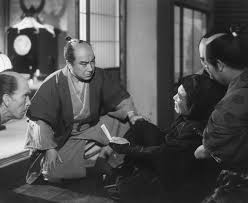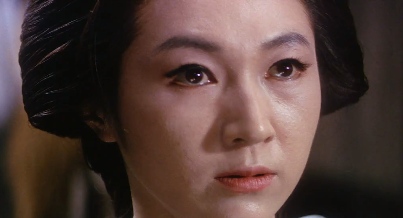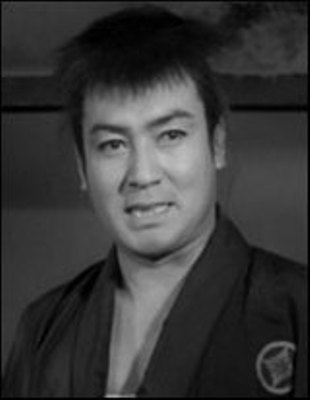Physical Address
304 North Cardinal St.
Dorchester Center, MA 02124

(Continued from page 1)
Unlike Gonpachi in A Bloody Spear at Mount Fuji, who follows his master with dog-like devotion, the Chief Retainer has no illusions about his lord’s virtues as a person – quite the contrary. Unable to impress upon Tadayuki the extreme danger in which he is putting himself and the clan, Daizen finally takes drastic action by ordering the warship Phoenix to be set on fire. When Tadayuki discovers this, though, the latter goes completely berserk and banishes the older man from the court.
There appears to me to be a certain perversity inherent in the myth of the faithful retainer of feudal lore. For the Japanese, it seems, there is little honor involved in faithfully serving an intelligent, kind and just lord. It is only when the lord displays the opposites of these qualities – as in Tadayuki’s case – that the true mettle of the retainer can be known. Uchida’s irony here is that Daizen proves himself a great one by consistently doing the exact opposite of what such a functionary would be expected to do under normal circumstances.
When his lord decides to built a warship, Daizen orders it destroyed. When Tadayuki orders him to commit seppuku, he refuses – not once, but twice. Finally, Daizen goes to one of the shogun’s chief advisors, Doi Toshikatsu, to inform on his own lord, though he’s careful to stress that, though Tadayuki had illegally trained foot soldiers and built a warship, he had not been seriously contemplating rebellion against the shogunate – which is actually the truth.
The final irony is that Doi Toshikatsu becomes angry not at Tadayuki but at Daizen, for flagrantly betraying Tadayuki. Japanese Wikipedia even claims that he was found to be insane for accusing his lord so shamelessly. In the end, Daizen is stripped of all his titles and sent into exile. (Jutayu, the narrative’s Iago-like intriguer, is also exiled, to his great shock.)
Tadayuki, by contrast, receives “a slap on the wrist.” He is sent to another comparably wealthy estate at Fukuoka with the warning that he must consult in future with a circle of elders before making any major decisions – exactly the arrangement that had existed in his father’s time. The reason given for this leniency is that the shogunate requires a bulwark against the power of the Christians, and regards the Kuroda clan as such a bulwark – despite the fact that Tadayuki had been the foolish dupe of secret Christians like his mistress, Ohide.
Daizen, however, doesn’t care about his exile or the loss of his titles. He only cares that no blood needed to be spilled to resolve the crisis: the ultimate proof of his selflessness. The real-life Daizen, though exiled to the Morioka Domain in the far north of the main Japanese island, Honshu, was treated well there by the ruling Nanbu clan and lived out the remainder of his days in prosperity and peace – a happy ending of sorts.1
I must confess that for me, the most moving and resonant aspect of this film is its depiction of the secret Christians, the victims of Iemitsu’s relentless persecution of their faith. It should be noted in fairness that the shogun’s harsh actions were not motivated merely by religious intolerance. In the previous century, both the Spanish and (especially) the Portuguese had brought into the country mercenaries as well as missionaries, with the apparent intent of ultimately overthrowing the shogunate and turning Japan into a Christian colony. Partly as a reaction to this, Iemitsu enacted the policy of sakoku, whereby all contact between Japanese and Europeans eventually became extremely limited, so that whole generations of ordinary Japanese would live and die without ever seeing the face of a European.2
This situation was disastrous for the many Christians converts, now living in a country with fewer and fewer priests, and thus left adrift in a nation that regarded them as a malign foreign presence in their own land. This film depicts the era just prior to the period in which the remaining Japanese Christians would be forced to either abjure their faith completely, go underground to practice their unique version of the religion in total secrecy (the so-called kakure kirishitan: “hidden Christians”), or accept martyrdom.
Since I first saw this film, I’ve been intrigued by its dark portrait of a persecuted sect of true believers, like the early Christians hiding in the ancient Roman catacombs. Uchida clearly regards these people with great sympathy, despite the fact that the protagonist of the film is their enemy. The filmmaker recognizes and appreciates the fact that they are fighting not only for their lives, but for something they regard as much more important: a vision of personal and perhaps national salvation. In his review of Endo Shusaku’s Silence, the acclaimed novel set in the period of the Christian persecutions, which both Shinoda Masahiro and Martin Scorsese adapted to film, John Updike makes a crucial point about the true beneficiaries of Christian ideology, as asserted by Endo in his book: “In a culture [referring to the West] where Christianity has established itself as an institution of the comfortable, it can be forgotten that its prime appeal was and still should be to the wretched.”3
The Christians depicted in the film are not “wretched” in the sense of destitute, but they are desperate and alone, turning to the most extreme measures to save themselves and thus preserve their faith in Japan. In the end, the film never quite clarifies what their ultimate goal might have been in manipulating Tadayuki into building his illegal warship, The Phoenix. Did they seriously think that they could defeat the Tokugawa in a war and install a more Christian-friendly regime? Or did they believe that destabilizing the balance of power in the country would somehow take the heat off themselves, as the clans would then be too busy fighting each other to oppress them?

All these mysteries coalesce around the fascinating character of Ohide, Tadayuki’s Christian mistress. After the lord first meets her, she goes for guidance to another Christian, Arikawa, and he instructs her to obey Tadayuki in all things. He then produces a small silver cross, which she stares at as if hypnotized. In a later scene, she arrives at a meeting of several co-religionists, wearing an outfit that makes her look like the Virgin Mary, to mourn the death of another Christian named Lorenzo, who has just been martyred. In the room, they assemble a large cross to pray to, and she gazes upon this relic with awe. The actress Takachiho Hizuru seems to me excellent in this important role: her character looks upon this symbol of her redeemer with a much more intense love than she could ever feel for a mere man. The irony of her situation is that there’s no doubt (though this of course is never stated explicitly) that the relationship between Tadayuki and Ohide is a sexual one, which means that she is being called upon by her confederates to sin to help save her community.
These paradoxes come to a head during the festival scene, described in detail by IUTAS member Akasaka Daisuke on this website’s Members Page. During a public celebration held by the Kuroda clan, Ohide is instructed by Arikawa to meet a priest who will be wearing a mask which, like her own, will have the mark “X” (a sideways crucifix?) painted on its forehead. Her problem is how to get to the festival to locate her contact, since she is stuck with Tadayuki inside the court and the festival is taking place outside the gates. Her ingenious solution is to manipulate her lord into bringing the festival inside. For Tadayuki, while wearing the X mask and feigning drunkenness, Ohide performs a highly suggestive dance á la Salome, and the lovestruck (and genuinely drunk) Tadayuki follows her from room to room in the palace, until she begs him to open the gates to let the revelers in, which he does. She then mixes with the crowd in the courtyard, until she finally finds the priest wearing the other “X” mask, who gives her further instructions.
All this suggests a spy movie, and these scenes certainly play that way. Unusually for a spy film, though, we never find out what ultimately happens to this Japanese “Mata Hari,” because, after being exposed by Daizen, she goes into hiding and vanishes from the narrative. It’s rather as if either Uchida or the screenwriter, Takaiwa Hajime, or both, could not bear to see the character either killed or imprisoned. However, her sudden flight merely delays the inevitable decision she will have to make: to either give up her faith or die for it.4

About halfway through the narrative, the shogunate, concerned about the rumors it is hearing about the Kuroda Clan and its giant warship, sends one of its most trusted retainers, Takenaka Unemenokami, to investigate and, if he finds the ship, to destroy it and dissolve the clan. Since this character is played by Ōtomo Ryūtarō (The Master Spearman), who had been active in films from the mid-1930s, and was one of the most popular swordfighting stars of the postwar era, we would reasonably expect sparks to fly between him and Kataoka Chiezō, who plays Daizen.
Unfortunately, nothing like this ever happens, and the conflict between the two characters remains disappointingly subdued, even cerebral. (However, it should be noted that this restraint is entirely consistent with Daizen’s character, as he always seeks to avoid bloodshed at all costs.) Daizen defeats his adversary not by directly confronting him militarily, but through cunning. When he meets Takenaka en route to the clan’s domain, he challenges the somewhat bewildered official to a game of Go, an offer the latter cannot politely decline. During the game, Uchida cross-cuts between shots of the two men sitting across from one another at the board and images of the Phoenix burning.
Takenaka immediately realizes that Daizen is diverting his attention to buy time to destroy the evidence of his lord’s guilt. Takenaka praises the counselor for his brilliant strategy, which could refer to either the board game or to Daizen’s successful efforts to distract him from his mission. My take on the character is that Takenaka is morally conflicted: despite his duty to the shogun, he doesn’t see himself as Daizen’s enemy, and would rather not see him punished for doing what he thinks is right for his clan.
The visual approach of this film is totally different from that of the other film in which Uchida cast Ōtomo, The Master Spearman (1960). In that later film, there are plenty of close-ups and close shots to highlight Ōtomo’s more extroverted performance. In this earlier movie, however, human figures, including Ōtomo’s, tend to be filmed in medium shot or even long shot, like actors on a stage, creating a certain sense of detachment from the characters and their passions. (This is true even of the previously-mentioned scene featuring the erotic dance performed by Ohide for Tadayuki.) In its more objective approach, the film more closely resembles the prewar work of Mizoguchi Kenji or Yamanaka Sadao than the style of the younger generation of directors active at this time, like Kurosawa Akira or Ichikawa Kon.
But perhaps it was just this somewhat old-fashioned style to which Japanese critics of the time responded positively, because The Kuroda Affair ranked 14th in the Kinema Junpo poll for its year. Of the other two parts of the loose trilogy to which I previously referred, neither Rebellion from Below (1956) nor The Thief Is Shogun’s Kin (1958) appear anywhere within the top 30 of the critics’ lists for each film’s respective year. Then all three pictures sank into an oblivion from which, in my opinion at least, both the first- and second-cited of these three films definitely deserve to be rescued.
Though lacking both the charming humor and stirring action of A Bloody Spear at Mt. Fuji or the tragic intensity of the later Hero of the Red-Light District, this visually compelling film spotlights a fascinating period in Japanese history, and its somewhat theatrical approach may have served as preparation for Uchida’s adaptations of classic Japanese dramas, beginning with The Horse Boy the following year.
Plot summary of The Kuroda Affair from the Museum of Modern Art’s (MOMA) 2016 Retrospective of Uchida Tomu’s films
KINENOTE summary of the film, including synopsis (in Japanese)
The Sword and The Screen: The Japanese Period Film 1915-1960 (PDF document) – Pamphlet about 2012 New York Retrospective of Japanese period films, including The Kuroda Affair, which is profiled